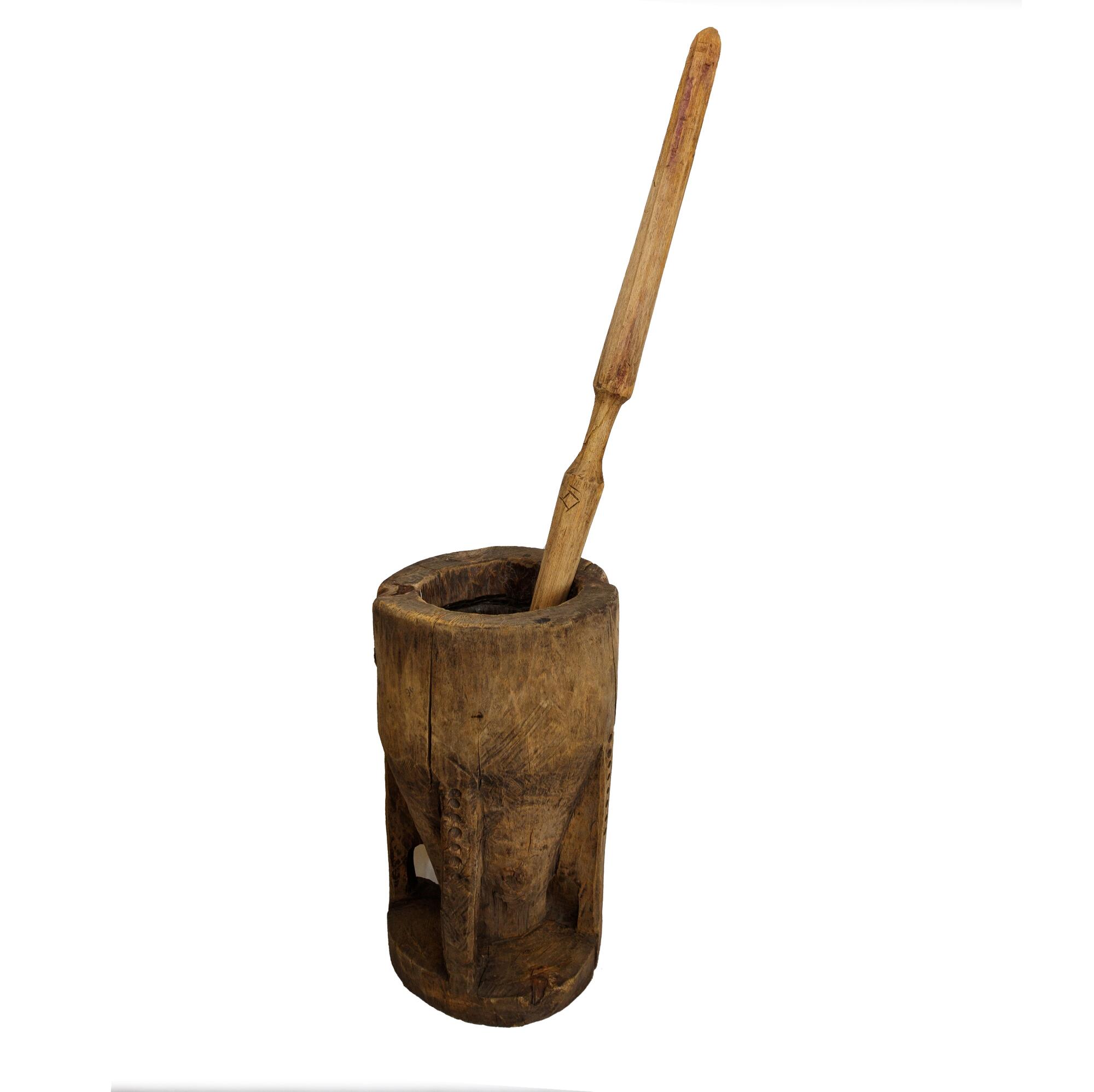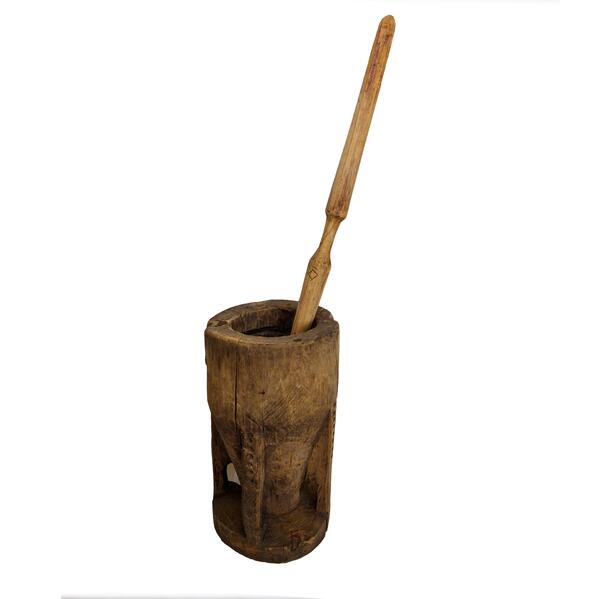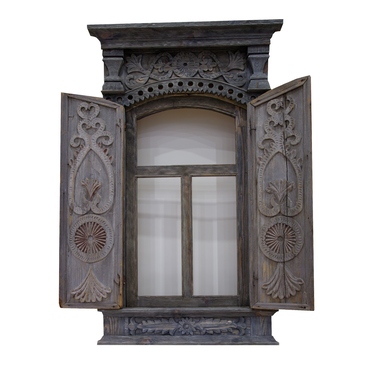The mortar and pestle came to the museum from the village of Podlesnaya Tavla, Saransk district, Penza province. The museum staff purchased them from local residents during an ethnographic expedition in the mid-1930s.
The Chovar mortar is hollowed out of a solid oak tree. It consists of a bowl, a base, and handles. The deep cone-shaped bowl is supported on the sides by four hollowed-out legs. The handles in the upper part are decorated with a number of round depressions.
The pekhtel pestle is a long stick, narrowed at the ends, with a waist for the hand in the middle. At the top of the pestle there is a mark of ownership “teshks” carved: a rhombus with straight branches and a slash under it.
The system of marking was preserved by the Erzya and Moksha until the middle of the 20th century. Stylized images of animals, birds, working tools, household items, geometric figures were used as family or personal property signs. They were put on wild-hive trees, household utensils, working tools, clothes; they marked plots of meadow and arable land, timber allotments.
The word “stupa” (the Russian word for a “mortar”) itself was derived from the old Russian word “stupat” — to shift one’s foot from place to place. Each house in the village had a mortar; they were hollowed out of hard wood: oak, birch, sometimes aspen. Mostly the lower part of the trunk without knots was used for them. A broadened and thickened platform made the mortar stable.
The mortars were used for scouring wheat, barley, millet and buckwheat grains, as well as for scutching treated plant fibres, soaked and dried stalks of hemp and flax. Scutching was one of the stages of obtaining fibers from these plants — hemp, hemp wool, tow.
A small amount of grain was placed in a mortar and ground with a pestle. The end of the pestle was often padded with iron to make the tool heavier and to prevent the wood from splitting. As they worked, they took the pestle out of the mortar and checked with their hands how many grains remained in the husk and how many were peeled. When most of the millet or buckwheat had been cleaned, the grains were poured into another bowl and the next portion was pounded.
When the work was done, the mortar was turned upside down and put together with the pestle in a corner. The groats were scattered over a clean canvas, winded, then collected in a bowl and washed with water. They always pounded exactly as much groats as was necessary for cooking gruel at the moment or for one or two weeks, since during the long storage of pounded groats could go rancid.
There were many rules and prohibitions associated with the mortar. According to myths, one should never leave the pestle in the mortar for the night, otherwise at night the evil spirits would grind illness with it and then scatter it among people. Also, the mortar was never left open: “otherwise you will not close your mouth before you die.” Often the mortar is mentioned in Russian folk proverbs and sayings. “You can’t pound her even in a mortar, ” one says about a stubborn girl; “Make him grind, so he’ll break the bottom in the mortar” — about a stupid man, “A mortar doesn’t eat oat meal, but it feeds the world”, “You can’t beat a fool in a mortar”, “A witch hatched him in a mortar “.
The Chovar mortar is hollowed out of a solid oak tree. It consists of a bowl, a base, and handles. The deep cone-shaped bowl is supported on the sides by four hollowed-out legs. The handles in the upper part are decorated with a number of round depressions.
The pekhtel pestle is a long stick, narrowed at the ends, with a waist for the hand in the middle. At the top of the pestle there is a mark of ownership “teshks” carved: a rhombus with straight branches and a slash under it.
The system of marking was preserved by the Erzya and Moksha until the middle of the 20th century. Stylized images of animals, birds, working tools, household items, geometric figures were used as family or personal property signs. They were put on wild-hive trees, household utensils, working tools, clothes; they marked plots of meadow and arable land, timber allotments.
The word “stupa” (the Russian word for a “mortar”) itself was derived from the old Russian word “stupat” — to shift one’s foot from place to place. Each house in the village had a mortar; they were hollowed out of hard wood: oak, birch, sometimes aspen. Mostly the lower part of the trunk without knots was used for them. A broadened and thickened platform made the mortar stable.
The mortars were used for scouring wheat, barley, millet and buckwheat grains, as well as for scutching treated plant fibres, soaked and dried stalks of hemp and flax. Scutching was one of the stages of obtaining fibers from these plants — hemp, hemp wool, tow.
A small amount of grain was placed in a mortar and ground with a pestle. The end of the pestle was often padded with iron to make the tool heavier and to prevent the wood from splitting. As they worked, they took the pestle out of the mortar and checked with their hands how many grains remained in the husk and how many were peeled. When most of the millet or buckwheat had been cleaned, the grains were poured into another bowl and the next portion was pounded.
When the work was done, the mortar was turned upside down and put together with the pestle in a corner. The groats were scattered over a clean canvas, winded, then collected in a bowl and washed with water. They always pounded exactly as much groats as was necessary for cooking gruel at the moment or for one or two weeks, since during the long storage of pounded groats could go rancid.
There were many rules and prohibitions associated with the mortar. According to myths, one should never leave the pestle in the mortar for the night, otherwise at night the evil spirits would grind illness with it and then scatter it among people. Also, the mortar was never left open: “otherwise you will not close your mouth before you die.” Often the mortar is mentioned in Russian folk proverbs and sayings. “You can’t pound her even in a mortar, ” one says about a stubborn girl; “Make him grind, so he’ll break the bottom in the mortar” — about a stupid man, “A mortar doesn’t eat oat meal, but it feeds the world”, “You can’t beat a fool in a mortar”, “A witch hatched him in a mortar “.



